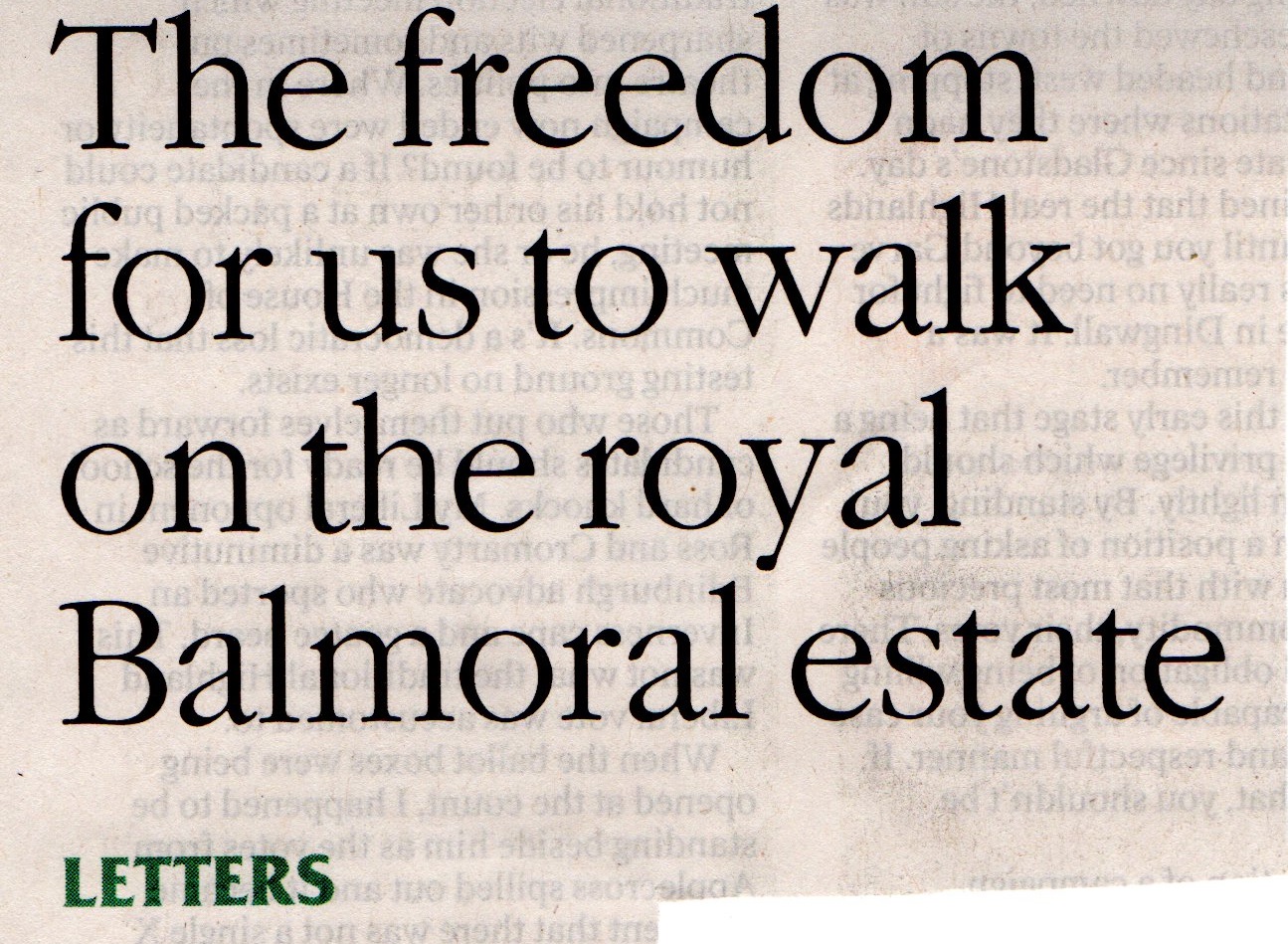
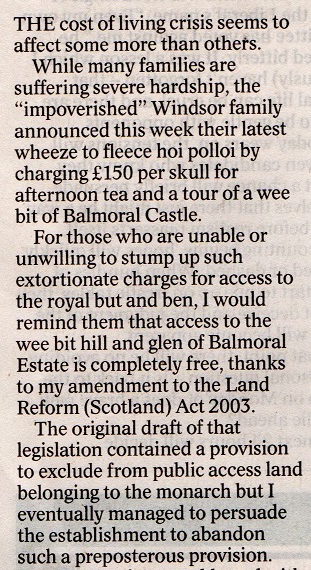
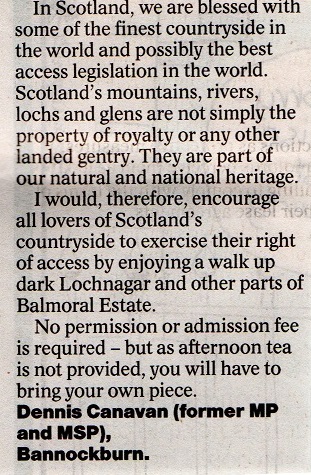
On election day, 4th July, after the anaemic campaigns of the major parties, it was good to see some real politics being given prominence in the Herald and to be reminded of the time when the Scottish Parliament was prepared to introduce radical new laws.
The royal family, the Scottish establishment and access rights
Dennis Canavan’s letter does not quite tell the whole story about access rights to the private royal estates in Scotland. In the original proposals, as negotiated between the landowning and outdoor recreational organisations at the Access Forum, there was no question as to Balmoral being included in access rights. A number of us were, however, invited to Balmoral for tea – free! – with the Duke of Edinburgh to provide re-assurance about the proposals. I remember the occasion mainly because I wore a rather battered sports jacket and Prince Philip gave me rather more time than the suits.
The draft legislation that eventually emerged from the civil service was very different to what the Access Forum had proposed to Scottish Ministers and included provisions to exempt the private royal estates in Scotland from access rights. While it is possible the royal family lobbied behind the scenes to have Balmoral exempted, they had in fact long been supportive of access for certain purposes, such as hillwalking and mountaineering, and had provided Gelder Shiel bothy to those ends.
That history suggests they didn’t see the creation of public access rights in Scotland as being contrary to their own private interests and the proposals to exempt Balmoral from access rights appear more likely to have originated from the Scottish Establishment and what they thought the royal family wanted/needed, rather than from the royal family itself. However, without MSPs like Dennis Canavan prepared to challenge that establishment, I don’t believe that exemption in the Land Reform (Scotland) Act 2003 would have been removed.
The Scottish Parliament, the royal family and the protection of wildlife
Since 2003 it appears to have been all downhill when it comes to MSPs in the Scottish Parliament successfully requiring the Royal Family should be subject to the law like everyone else. A couple of months ago (see here), I highlighted that the royal estates in Scotland were exempted from the provisions in the Wildlife Management and Muirburn (Scotland) Act 2024 that allow law enforcement agencies – in certain very limited circumstances – to enter, search and seize materials from premises unannounced if that would help the detection of certain crimes:
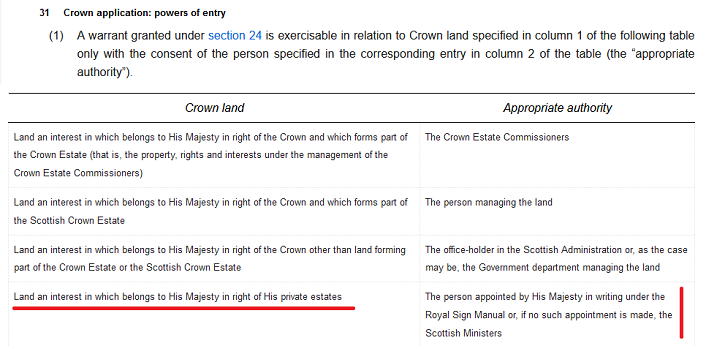
The requirement to have a warrent from a JP or Sheriff before the powers under Section 24 can be exercised provides safeguards to all landowners against the law enforcement agencies abusing their power but this was not enough for the Royal Family. In the case of the private royal estates authority also needs to be granted by someone nominated by His Majesty or failing that Scottish Ministers. Effectively what this means is those managing the royal estates in Scotland get advance notification of any investigation of wildlife crimes that are suspected to have taken place on their land. This blows a major hole in legislation which was intended to reduce wildlife crimes associated with intensive grouse moor management
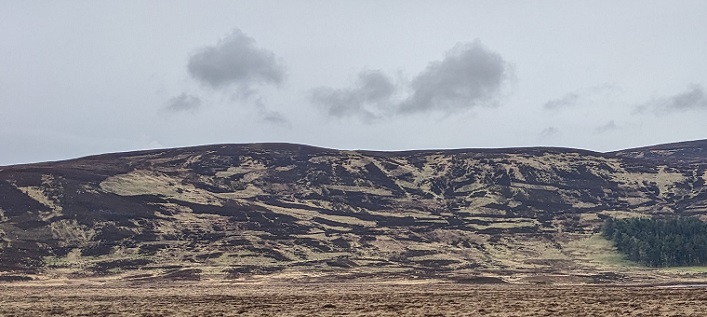
At the Stage 3 Reading of the Wildlife Management and Muirburn Bill not a single MSP proposed an amendment to these exemptions. That was despite the revelations in the Guardian three years ago (see here) about how the Queen was using her position to protect the Royal Family’s private interests. As Andy Wightman subsequently explained (see here) this is deeply undemocratic and contrary to the founding principles of the Scottish Parliament.
All of this prompted me to take a look at other laws passed by the Scottish Parliament designed to protect nature and wildlife. What I have found is the Wildlife and Natural Environment (Scotland) Act 2011 amended the enforcement provisions in the Part 1 of Wildlife and Countryside Act 1981, which were designed to protect wildlife, by introducing exemptions for the private royal estates:
 This is telling. I don’t think many people realise the Scottish Parliament has introduced exemptions to UK legislation which originally treated the privately owned royal estates like any other landowner. Since the early years of the Scottish Parliament and the presence of MSPs like Denis Canavan, the situation has become worse, not better. Clearly, too, the royal family are not nearly as relaxed about wildlife protection as they are about public access.
This is telling. I don’t think many people realise the Scottish Parliament has introduced exemptions to UK legislation which originally treated the privately owned royal estates like any other landowner. Since the early years of the Scottish Parliament and the presence of MSPs like Denis Canavan, the situation has become worse, not better. Clearly, too, the royal family are not nearly as relaxed about wildlife protection as they are about public access.
Why the silence about the royal family’s use their powers to protect their private interests?
This failure of the Scottish Parliament is not entirely the fault individual politicians. The main political parties have made it very difficult for their members to speak out. It is notable that Denis Canavan was expelled from the Labour Party and Angus McNeil, who spoke out against the exemption of the Queen from the Heat Networks bill (see here), was subsequently expelled from the SNP (and has just lost his parliamentary seat for the Western Isles).
Meantime, many of the voluntary organisations which are supposed to protect our wildlife and which most MSPs rely on for advice about amendments to legislation, have royal patrons and presidents. In May, the RSPB, one of the main organisations which had pushed for the Wildlife Management and Muirburn Act, announced that King Charles had succeeded the Queen as their patron (see here). If King Charles is such a “consistent, active and inspiring champion for action on nature and climate” as RSPB claim in their news release, why weren’t they prepared to say in public that the royal estates should be subject to legislation designed to protect wildlife like everywhere else?
The environmental implications of land owned by the royal family being treated differently
The exemption of land owned by the royal family from certain legislative provisions designed to protect wildlife illustrate the failure to tackle an even bigger environmental issue, the degraded condition of nature in upland Scotland.
More specifically the way the state in Scotland, from the Scottish Government down to public authorities, kow tows to the royal family has prevented any meaningful reform of the sporting estates. These bear primary responsibility for damage to nature across upland Scotland through intensive grouse moor management and their maintenance of large numbers of red deer for shooting purposes. Since Queen Victoria the royal family have been the lynch pin of the sporting estate system.
This helps explain the failure of the Wildlife Management and Muirburn Act to ban burning on peat or land that would otherwise develop into woodland.
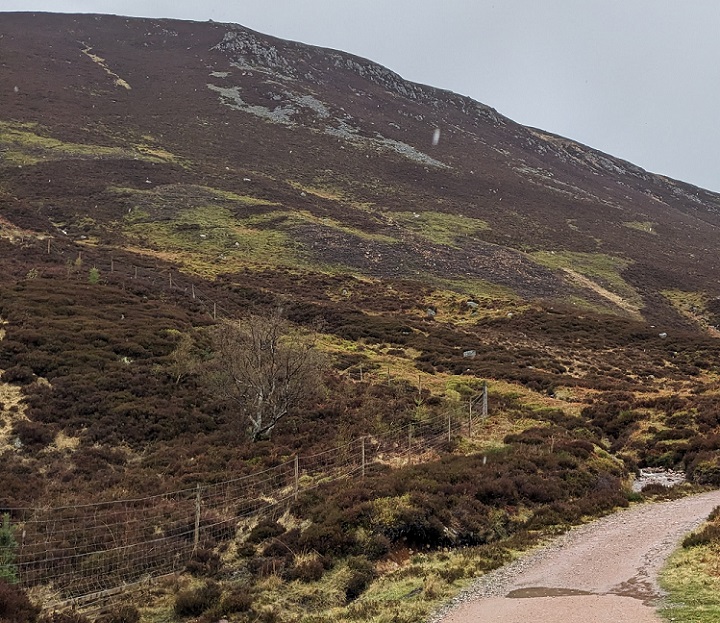
It also explains why NatureScot has failed to deal with the damaging numbers of deer at Caenlochan for over 20 years, why the new Section 7 Agreement there only aims to reduce deer density to 10 per square km by 2026 (see here) and why the Scottish Parliament has never investigated the issue as recommended by the report of the Deer Working Group. Basically the Scottish Government, NatureScot and the Cairngorms National Park Authority put the private “needs” of the royal family before their public duty to protect the natural environment and further its conservation.
I will provide further evidence of these issues in a forthcoming post on deer density at Balmoral, based on what I saw on a visit in May and a response to a Freedom of Information request about the new Caenlochan Section 7 Agreement. The point here is that we will need many more radical politicians, like Dennis Canavan, and many more radical environmentalists, like Adam Watson (who was spat on for criticising the way the royal family managed their land), if we are to have a chance of reforming the way sporting estates in Scotland are managed.

During the negotiations in the 1990s that eventually led to our right to roam legislation, passed by the Scottish Parliament in 2003, the Royal Family and their officials at Balmoral were very helpful. They had always respected the traditional freedoms for the public to take access over Balmoral estate, with the accepted exclusion of the garden ground immediately adjacent to the castle. That position did not change when the Royal Family were in residence. So, when dealing with other, less tolerant landowners, I frequently terminated those discussions with the remark “if public access is good enough with the Queen in charge at Balmoral it should be good enough for you”.
Such high standards as regards public access are not, however, reflected in other aspects of land management at Balmoral. The failure to reduce red deer numbers down to levels that permit the natural regeneration of montane and woodland habitats is a scandal. This needs to be a topic for discussion when the First Minister and King Charles have their next meeting.
Yes it’s very odd that the king is regarded by some as an environmentalist of some sort when he is clearly nothing if the sort. Rather the opposite of one in terms of his deeds.
Hi Nick,
A fascinating blog, as ever. Just one clarification – the RSPB is not ‘one of the main organisations behind Revive, the coalition for grouse moor reform…’ The members of the Revive coalition are the League Against Cruel Sports (Scotland), Friends of the Earth (Scotland), OneKind, Common Weal and Raptor Persecution UK.
Thanks Ruth, have been off phone networks in Outer Hebrides but have fixed
I lack any first hand insights into the Royal family’s management of Balmoral but do feel that the Royals are failing to show leadership in biodiversity conservation there. If we must have a ‘Royal Family’ why don’t they demonstrate their leadership to the citizenry on such matters? Many landowners will follow the Royals lead and also control deer numbers if the King makes that his management priority.